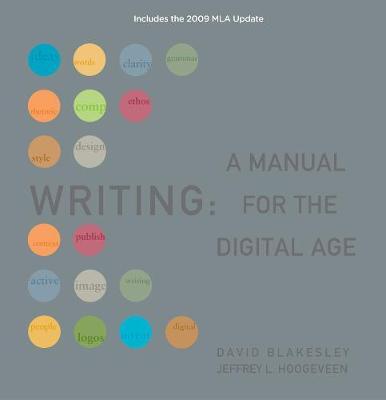Full Product Details
Author: David Blakesley (Clemson University) ,
Jeffrey Hoogeveen (Lincoln University)
Publisher: Cengage Learning, Inc
Imprint: Heinle & Heinle Publishers Inc.,U.S.
Edition: International Edition
Dimensions:
Width: 19.50cm
, Height: 3.70cm
, Length: 19.30cm
Weight: 1.429kg
ISBN: 9781428290297
ISBN 10: 142829029
Pages: 1168
Publication Date: 01 June 2009
Audience:
College/higher education
,
Tertiary & Higher Education
Format: Hardback
Publisher's Status: Out of Print
Availability: In Print

Limited stock is available. It will be ordered for you and shipped pending supplier's limited stock.
Reviews
Part I: MANAGING YOUR WRITING. 1. Writing and Rhetoric in Context. 2. Planning Your Writing Projects. 3. Invention and Inquiry. 4. Drafting and Shaping Content. 5. Developing Paragraphs. 6. Revising, Editing, and Proofreading. Part II: READING AND WRITING CRITICALLY. 7. Understanding Academic Genres. 8. Reading Critically. 9. Reading Literature Critically. 10. Reading Images Critically. 11. Writing Arguments. 12. Writing for Business and the Workplace. 13. Writing on the Spot: Essay Examinations. Part III: CONDUCTING RESEARCH. 14. Conceptualizing the Research Project. 15. Online Research. 16. Library and Field Research. 17. Using Information Effectively. 18. Research and Plagiarism in the Digital Age. Part IV: CITING SOURCES. 19. Citing Sources in MLA Style. 20. Citing Sources in APA Style. 21. Citing Sources in CMS Style. 22. Citing Sources in CSE Style. 23. Using CGOS Citations for Online Sources. Part V: DESIGNING AND PRESENTING INFORMATION. 24. Using Visuals to Inform and Persuade. 25. Desktop Publishing and Graphic Design for Writers. 26. Designing Interactive Oral Presentations. Part VI: WRITING IN DIGITAL SPACES. 27. Reading and Writing Email Purposefully. 28. Networking with Others on the Web. 29. Writing and Rhetoric on the Web. 30. Designing Simple Web Pages. 31. Designing Complex Websites. 32. Multimedia Composing. Part VII: MAKING CHOICES ABOUT STYLE. 33. Sentences in Context. 34. Parallelism. 35. Coordination and Subordination. 36. Concise Sentences. 37. Variety and Emphasis. 38. Effective Word Use. 39. Language and Diverse Audiences. Part VIII: UNDERSTANDING AND REVISING SENTENCES. 40. Parts of Speech and Sentence Structure. 41. Fragments. 42. Run-Ons and Comma Splices. 43. Pronouns. 44. Verbs. 45. Subject-Verb Agreement. 46. Adjectives, Adverbs, and Modifying Phrases. Part IX: PUNCTUATING WITH PURPOSE. 47. End Punctuation: Defining Sentence Types and Boundaries. 48. Commas: Defining Boundaries within Sentences. 49. Semicolons: Expressing Equal Relationships among Closely Related Ideas. 50. Colons: Introducing Explanations and Quotations. 51. Apostrophes: Showing Possession and Forming Contractions. 52. Quotation Marks: Attributing Words to People and Conveying Tone. 53. Other Punctuation Marks. Part X: UNDERSTANDING MECHANICS. 54. Abbreviations. 55. Numbers. 56. Italics. 57. Capitalization. 58. Spelling and Hyphens. Part XI: GRAMMAR FOR MULTILINGUAL WRITERS. 59. ESL Writing for Academic Purposes. 60. Nouns and Articles. 61. Verbs and Verbals. 62. English Sentence Structure. Part XII: GLOSSARIES. Glossary of Technology and Web Terms. Glossary of Grammatical Terms. Glossary of Usage.
Author Information
David Blakesley is the Campbell Chair in Technical Communication and Professor of English at Clemson University. Previously, he was a Professor of English and Director of Professional Writing at Purdue University. In 2002, he also founded Parlor Press, a scholarly publishing company that has already published some 35 titles and is growing rapidly. Dave's teaching and research interests are in the areas of digital and multimedia publishing, visual rhetoric, modern rhetorical theory, and technical communication. Jeff Hoogeveen is a professor and the Director of the Composition Program at Lincoln University. He teaches composition, advanced writing and film courses.




